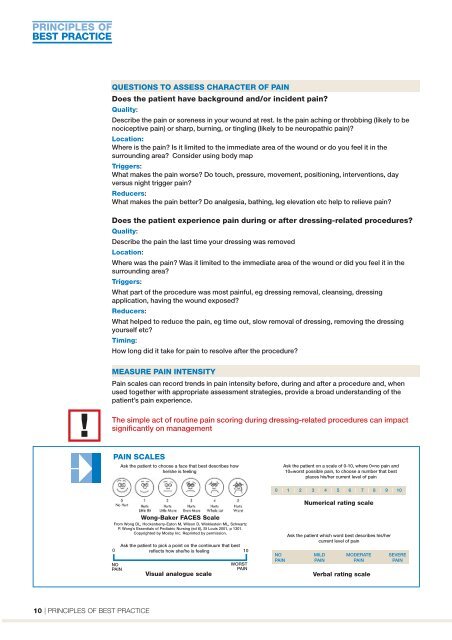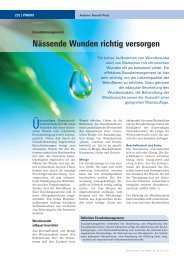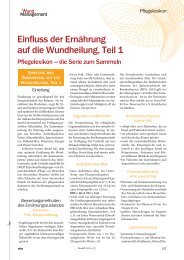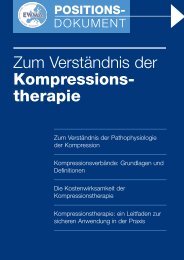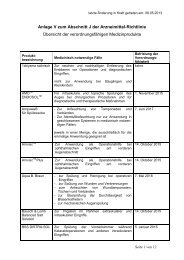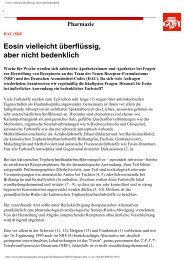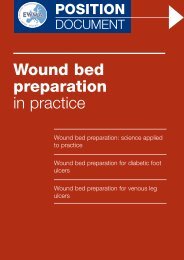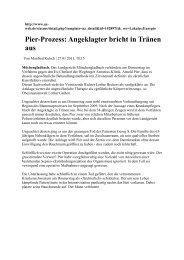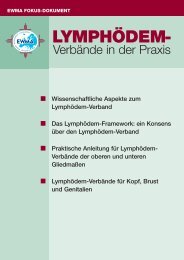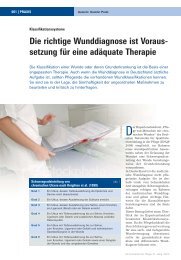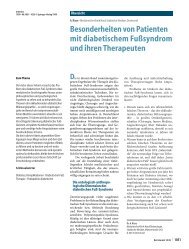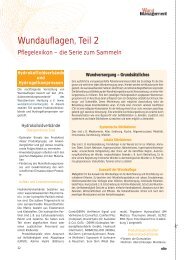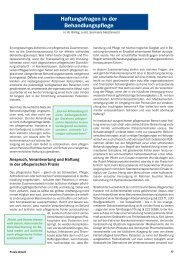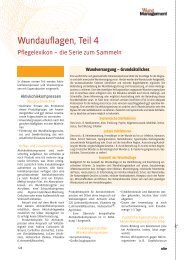Minimising pain at wound dressing-related procedures A ... - Less Pain
Minimising pain at wound dressing-related procedures A ... - Less Pain
Minimising pain at wound dressing-related procedures A ... - Less Pain
You also want an ePaper? Increase the reach of your titles
YUMPU automatically turns print PDFs into web optimized ePapers that Google loves.
PRINCIPLES OF<br />
BEST PRACTICE<br />
QUESTIONS TO ASSESS CHARACTER OF PAIN<br />
Does the p<strong>at</strong>ient have background and/or incident <strong>pain</strong>?<br />
Quality:<br />
Describe the <strong>pain</strong> or soreness in your <strong>wound</strong> <strong>at</strong> rest. Is the <strong>pain</strong> aching or throbbing (likely to be<br />
nociceptive <strong>pain</strong>) or sharp, burning, or tingling (likely to be neurop<strong>at</strong>hic <strong>pain</strong>)?<br />
Loc<strong>at</strong>ion:<br />
Where is the <strong>pain</strong>? Is it limited to the immedi<strong>at</strong>e area of the <strong>wound</strong> or do you feel it in the<br />
surrounding area? Consider using body map<br />
Triggers:<br />
Wh<strong>at</strong> makes the <strong>pain</strong> worse? Do touch, pressure, movement, positioning, interventions, day<br />
versus night trigger <strong>pain</strong>?<br />
Reducers:<br />
Wh<strong>at</strong> makes the <strong>pain</strong> better? Do analgesia, b<strong>at</strong>hing, leg elev<strong>at</strong>ion etc help to relieve <strong>pain</strong>?<br />
Does the p<strong>at</strong>ient experience <strong>pain</strong> during or after <strong>dressing</strong>-rel<strong>at</strong>ed <strong>procedures</strong>?<br />
Quality:<br />
Describe the <strong>pain</strong> the last time your <strong>dressing</strong> was removed<br />
Loc<strong>at</strong>ion:<br />
Where was the <strong>pain</strong>? Was it limited to the immedi<strong>at</strong>e area of the <strong>wound</strong> or did you feel it in the<br />
surrounding area?<br />
Triggers:<br />
Wh<strong>at</strong> part of the procedure was most <strong>pain</strong>ful, eg <strong>dressing</strong> removal, cleansing, <strong>dressing</strong><br />
applic<strong>at</strong>ion, having the <strong>wound</strong> exposed?<br />
Reducers:<br />
Wh<strong>at</strong> helped to reduce the <strong>pain</strong>, eg time out, slow removal of <strong>dressing</strong>, removing the <strong>dressing</strong><br />
yourself etc?<br />
Timing:<br />
How long did it take for <strong>pain</strong> to resolve after the procedure?<br />
MEASURE PAIN INTENSITY<br />
<strong>Pain</strong> scales can record trends in <strong>pain</strong> intensity before, during and after a procedure and, when<br />
used together with appropri<strong>at</strong>e assessment str<strong>at</strong>egies, provide a broad understanding of the<br />
p<strong>at</strong>ient’s <strong>pain</strong> experience.<br />
!<br />
The simple act of routine <strong>pain</strong> scoring during <strong>dressing</strong>-rel<strong>at</strong>ed <strong>procedures</strong> can impact<br />
significantly on management<br />
PAIN SCALES<br />
Ask the p<strong>at</strong>ient to choose a face th<strong>at</strong> best describes how<br />
he/she is feeling<br />
Ask the p<strong>at</strong>ient on a scale of 0-10, where 0=no <strong>pain</strong> and<br />
10=worst possible <strong>pain</strong>, to choose a number th<strong>at</strong> best<br />
places his/her current level of <strong>pain</strong><br />
0 | 1 | 2 | 3 | 4 | 5 | 6 | 7 | 8 | 9 | 10<br />
Numerical r<strong>at</strong>ing scale<br />
Wong-Baker FACES Scale<br />
From Wong DL, Hockenberry-E<strong>at</strong>on M, Wilson D, Winklestein ML, Schwartz<br />
P. Wong’s Essentials of Pedi<strong>at</strong>ric Nursing (ed 6), St Louis 2001, p 1301.<br />
Copyrighted by Mosby Inc. Reprinted by permission.<br />
Ask the p<strong>at</strong>ient to pick a point on the continuum th<strong>at</strong> best<br />
0 reflects how she/he is feeling<br />
10<br />
NO<br />
PAIN<br />
Visual analogue scale<br />
WORST<br />
PAIN<br />
Ask the p<strong>at</strong>ient which word best describes his/her<br />
current level of <strong>pain</strong><br />
NO MILD MODERATE SEVERE<br />
PAIN PAIN PAIN PAIN<br />
Verbal r<strong>at</strong>ing scale<br />
10 | PRINCIPLES OF BEST PRACTICE


